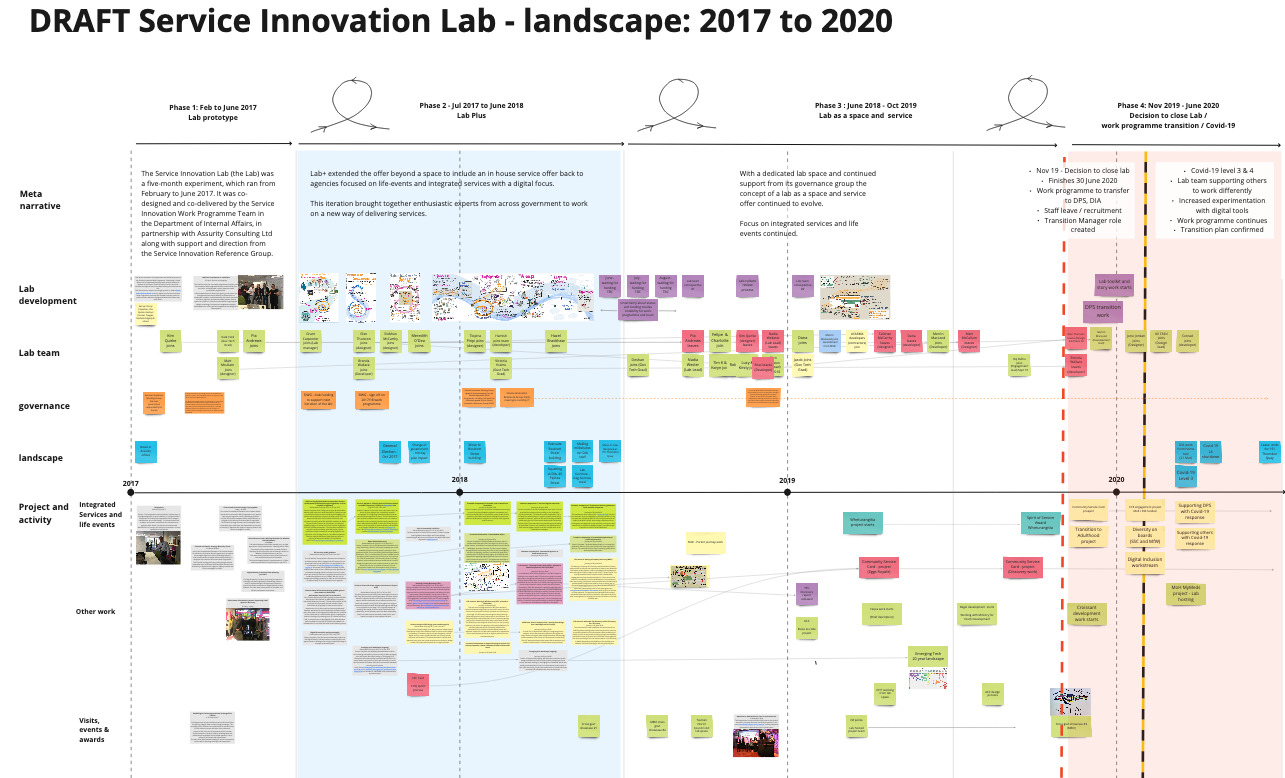How the Lab adapted and evolved its approach over three years
Lab history - snapshot
While the Lab’s principles stayed consistent how it operated and where it focused evolved. Some of this was guided by the team adapting and iterating based on hands on experience and learning. Other times it was shaped by the wider environment including changes to the authorising environoment, funding, a change of government and practical challenges like the need to move offices three times.
A important reflection is the importance of the ability change, adapt and anticipate is key to the sustainability of labs.
We have loosely framed this around four key phases below. This includes the final period of transistion and closure of the Lab.
Phase 1 - Lab as a space (Feb - Jun 2017)
The Service Innovation Lab was a 5-month experiment, which ran from February to June 2017. It was co-designed and co-delivered by the Service Innovation Work Programme team in the Department of Internal Affairs, in partnership with Assurity Consulting Ltd along with support and direction from the Service Innovation Reference Group.
It provided a place where teams from different agencies, NGOs, private sector and New Zealanders could a physical space conducive to collaboration and experimentation, supported by skilled lean and agile coaches to help teams rapidly evolve their working methods.
Features
- Lab as a space (based inside of government)
- External expertise (procured)
- Time-limited
- Senior Support and mandate
- Cross-government focus
- Prototyping new ways of working across government
Landscape
- Established public service reform agenda (Better Public Services)
- Increased expectation that agencies will collaborate and work in joined-up ways
- Increased interest in human-centred approaches across government
- Importance of digital services and digital identity amplified
Phase 2 - Lab as a service (July 2017 to Jun 2018)
Building on the Lab as a space concept, Lab Plus extended the offer beyond a space to include an in house service to agencies.
It focused on life-events and integrated services with a digital focus. A work programme and further funding was approved by the Lab’s cross-government governance group. This iteration brought together staff from across government to work on a new way of delivering government services.
A number of key projects progressed to implementation. Other pieces laid foundations and secured buy-in for further work. Several barriers also began to emerge which were presented to sponsors.
Features
- Increased internal capability and expertise within the Lab team (reduced reliance on external expertise)
- 12-month work programme
- Focus on life events and integrated services as catalyst for cross-government working
- Senior support and resources committed
Landscape
- General election and change of government - Oct 2017
- New government’s 100-day plan took priority over lab work for partner agencies
- Team required to move offices three times in 12 months - once post-earthquake
- Dedicated lab space established (close to partner agencies)
Phase 3 - Lab as a space and a service (Jun 18 - Jun 20)
This phase sought to embed work to make it easier for people to access / use government services. The lab offered both a physical space and a multi-disciplinary team building onthe previous18 months experience innovating inside government.
For those teams working closely with the Lab team, the relationship became increasingly valued for the capability uplift opportunity it offered plus ad-hoc connections with other government teams.
It was also a period of uncertainty. With resources, work programme alignment and an uncertain authorising environment leading to flux in the Lab’s role and higher turnover in staff.
Work on integrated services continued but some of the barriers to collaboration identified in phase 2 persisted.
Features
- Lab as a dedicated neutral space (based outside of government) increasingly popular
- Work supplemented by future-thinking e.g. Emerging Tech workstream
- Increased profile - lab hosted international visitors (with NZTE)
- Increased range of expertise in team but also higher turnover of staff
Landscape
- New government priorities around wellbeing and digital became more established
- Uncertainty about lab funding and future viability
- Continued demand and interest in human-centred approaches across government
- Wellington based alternatives emerged as other innovation partners for agencies
Phase 4 - Lab close and transition (Oct 19 - Jun 20)
In late 2019, DIA announced it was closing the Lab and this would happen by 30 June, 2020. The decision was part of the move to explore system-wide delivery of integrated services, addressing significant barriers the Lab had faced in terms of funding structures and the single-agency approach. Much of the work programme transitioned to the relevant lead agencies and DIA’s Digital Public Service branch aimed to continue a level of support to agencies that did not have in-house service designers. It also started exploring, with other agencies, a better approach to delivering integrated services at a system level.
The transition period coincided with the arrival of Covid-19 in early 2020. The wider government response and need to work remotely under Alert Level 3 and 4 enabled the Lab to help other teams by sharing its experience of agile and digital collaborative practice, while also continuing to deliver its work programme.
Features
- Developing of lab toolkit and sharing approach
- Re-emergence of earlier discovery work
- Focus on integrated services
- Cross department support during response to COVID-19
Landscape
- Restructure and changes in home agency
- Managing transition of lab work programme to new host teams
- Early stages of COVID-19 and preparation for Level 3 and 4
- Shift to remote working with focus on online collaborative approaches


